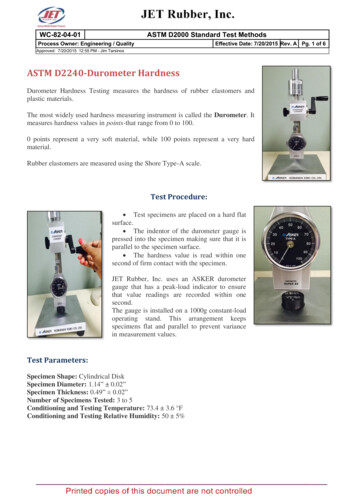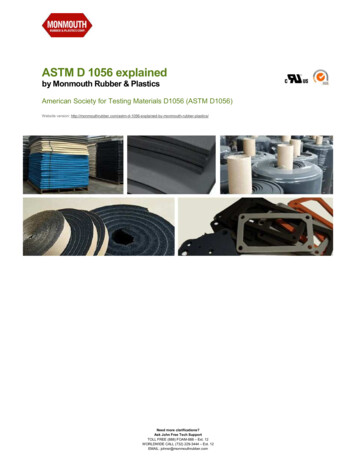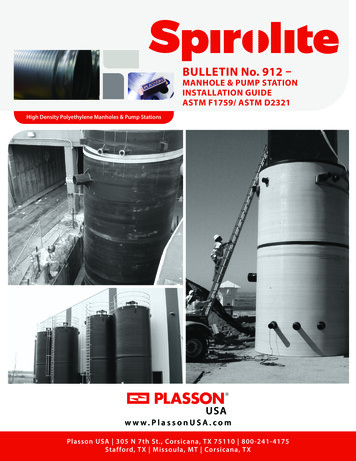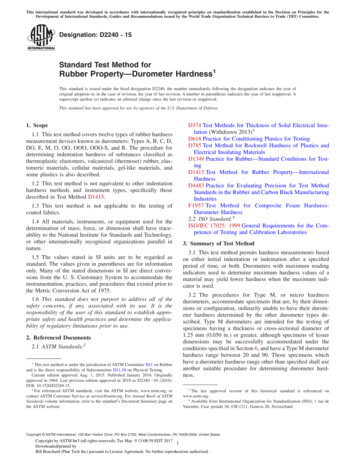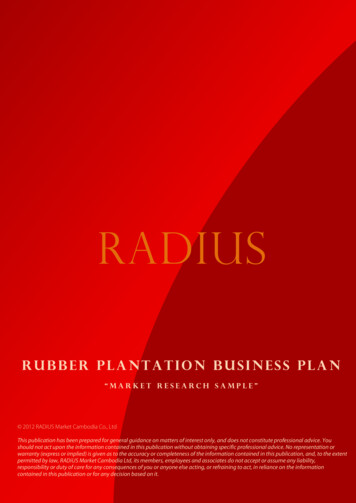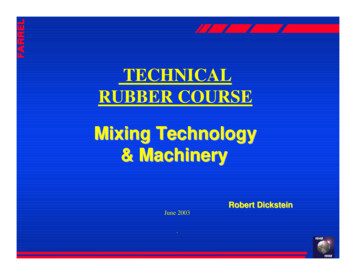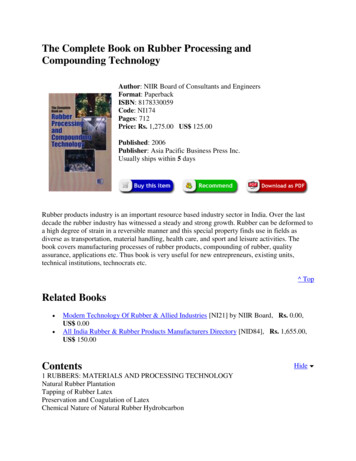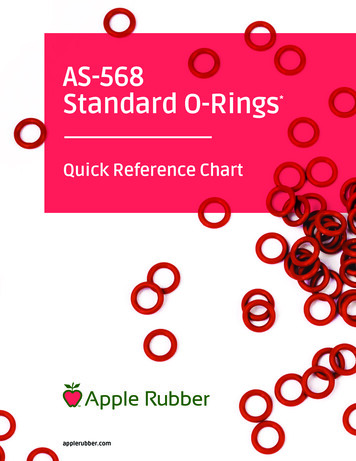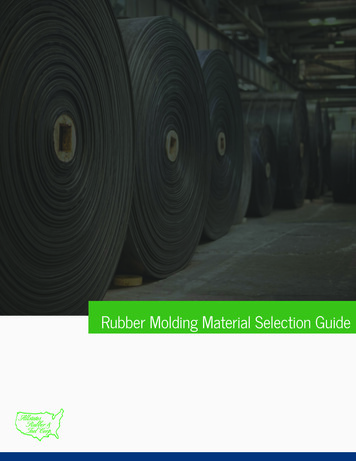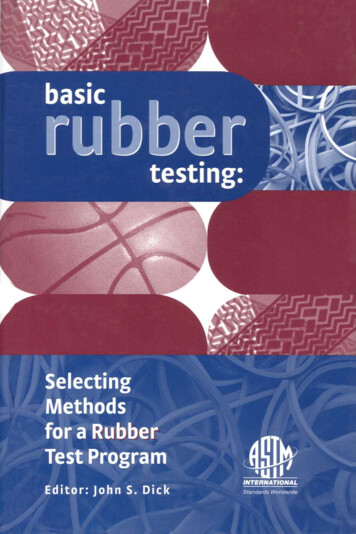
Transcription
Basic Rubber Testing:S e l e c t i n g M e t h o d s for aRubber Test ProgramJohn S. Dick, editorA S T M Stock Number: MNL39@INTERNATIONALA S T M International100 Barr H a r b o r DrivePO Box C700West Conshohocken, PA 19428-2959Printed in the U.S.A.
Library of Congress Cataloging-in-Production DataDick, John S.Basic rubber testing: selecting methods for a rubber test program/John S. Dick.p. cm."ASTM Stock Number: MNL39."Includes bibliographical references and index.ISBN 0-8031-3358-81. Rubber--Testing. I. Title.TA455.R8D53 2003678'.21'0287--dc212003056053Copyright 9 2003 ASTM International, West Conshohocken, PA. All rights reserved.This material may not be reproduced or copied, in whole or in part, in any printed,mechanical, electronic, film, or other distribution and storage media, without thewritten consent of the publisher.Photocopy RightsAuthorization to photocopy items for internal, personal or educational classroomuse, or the internal personal, or educational classroom use of specific clients, isgranted by ASTM International provided that the appropriate fee is paid to theCopyright Clearance Center, 222 Rosewood Drive, Danvers, MA 01923; Tel: 978750-8400; online: http://www.copyright.com/.NOTE: This manual does not purport to address all of the safety concerns, if any, associated with its use. It is the responsibility of the user of this manual to establish appropriate safety and health practices and determine the applicability of regulatorylimitations prior to use.Bridgeport, NJAug. 2003
ForewordTHIS PUBLICATION,Basic Rubber Testing: Selecting Methods for a Rubber Test Program, w a s s p o n s o r e d b y C o m m i t t e e D l l on R u b b e r a n d D24 on C a r b o nBlack. This is M a n u a l 39 in ASTM International's m a n u a l series.
Contents 1 7 6 1 7 6ForewordPrefaceAcknowledgment111XV. . .VlllCHAPTER 1Introduction--by John Dick1.1 History1.2 ASTM D l l Standards1.3 Purpose1.4 Economic Savings for Users and Producers Through TestMethod Rationalization1.5 Importance of Quality1.6 Standard Target Values and "Tolerance Stack-up"1.7 Testing Bias1.8 What Makes for a Good Standard Test Method?1.8.1 Accuracy1.8.2 Repeatability1.8.3 Reproducibility1.8.4 Stability1.8.5 Linearity1.9 The Rubber Process1.10 Raw Rubber and Compounding Ingredients1.11 The Recipe1112245789991011121313CHAPTER 2General Test Methods--by John Dick2.1 Introduction to the Rubber Test Laboratory2.1.1 Compounding Ingredient Storage System2.1.2 Weighing Systems2.1.3 Mixer Systems2.1.4 Curing Procedure2.2 General Methods2.2.1 Mooney Viscometer ASTM D 16462.2.1.1 Mooney Viscosity1717181920202022
CONTENTS2.2.22.2.32.2.42.2.52.2.62.2.72.2.82.2.1.2 Mooney Stress Relaxation Test2.2.1.3 Measuring Pre-Vulcanization CharacteristicsOscillating Disk Curemeter ASTM D 20842.2.2.1 ODR Cure Test ParametersRotorless Curemeter ASTM D 5289Rotorless Shear Rheometer ASTM D 62042.2.4.1 Elastic Torque (S')2.2.4.2 Viscous Torque (S")2.2.4.3 Tangent 8 (Delta)2.2.4.4 Storage (Elastic) Modulus (G')2.2.4.5 Loss (Viscous) Modulus (G')2.2.4.6 Dynamic Viscosity 0', 0", q*Tensile Properties ASTM D 412After-Cure Dynamic Properties for QualityAssurance and Development ASTM D 6601Other Cured Physical Property Measurements2.2.7.1 Tear Resistance ASTM D 6242.2.7.2 Air Oven Aging ASTM D 5732.2.7.3 Goodrich Flexometer Heat BuildupASTM D 6232.2.7.4 Flex Cracking Resistance2.2.7.5 Liquid Immersion Properties ASTM D 4712.2.7.6 Compression Set ASTM D 3952.2.7.7 Rubber Hardness ASTM D 22402.2.7.8 Abrasion Resistance ASTM D 22282.2.7.9 Low Temperature Properties ASTM D 10532.2.7.10 Ozone Resistance D 1171The Standard Classification System for RubberProducts used in Automotive Applications ASTM 5555657CHAPTER 3Testing Natural Rubber--by Alek Vare3.1 Introduction and History3.2 Sampling and Sample Preparation by ASTM D 14853.3 Technical Grades and Basis for Classification by ASTMD 22273.4 Methods for Chemical Analysis of Natural Rubber byASTM D 12783.4.1 Percent Dirt3.4.2 Volatile Matter3.4.3 Copper Content3.4.4 Manganese Content616163646566666667
CONTENTS3.53.63.73.83.4.5 % Ash3.4.6 Iron Content3.4.7 Acetone Extract3.4.8 NitrogenPlasticity Retention Index, ASTM D 3194Color Index ASTM D 3157Standard Test Method for Evaluation of Natural RubberASTM D 3184New Standard Test Method for Characterizing NaturalRubber Grades--ASTM D 6204, Part Bvii6767676868696970CHAPTER 4Testing Synthetic Rubber--by Julia B. Zimmerman4.14.24.34.44.54.6Synthetic Rubber History and NomenclatureConsumer-Producer AgreementPhysical Tests for Synthetic RubberStandard Test Recipes and Test ProceduresProcessability of SBR with the Mooney ViscometerChemical Tests for Synthetic Rubbers4.6.1 Organic Acids, Soap, Oil, Total Extractables4.6.1.1 Total Extractables4.6.1.2 Organic Acid and Soap4.6.1.3 Oil4.6.2 Volatile Matter4.6.3 Total and Water Soluble Ash4.6.4 Determination of Carbon Black in Masterbatch4.6.5 Percent Gel, Swelling Index, and Dilute SolutionViscosity4.6.6 Nitrogen Content of NBR (or HNBR)4.6.7 Test Methods for HNBR4.6.7.1 Unsaturation of HNBR by Iodine Value4.6.7.2 Unsaturation of HNBR by InfraredSpectrophotometry4.6.8 EPDM Tests4.6.8.1 Percent ENB or DCPD in EPDMTerpolymers4.6.9 SBR Tests4.6.9.1 Bound Styrene in SBR4.6.10 Tests for CIIR or BIIR4.6.10.1 Determination of Bromine in the Presenceof Chlorine by Oxygen Combustion4.6.11 General Comment on Determination of Metals 868686878788
viiiCONTENTSCHAPTER5Testing Carbon Black--by ]effery A. Melson5.1 Introduction5.1.1 How is Carbon Black Used?5.1.2 What are Surface Area, Structure and SurfaceActivity--Why are they important?5.2 Classification5.2.1 Basis for Classification (D 1765)5.3 Standard Reference Blacks5.3.1 Validation of Test Method Precision and Bias(D 4821)5.3.2 Improving Test Reproducibility Using ASTMReference Blacks (D 3324)5.4 Tests that Relate to Surface Area (Particle Size)5.4.1 Iodine Adsorption Number (D 1510)5.4.2 Nitrogen Adsorption5.4.3 CTAB (CetyltrimethylammoniumBromide) SurfaceArea (D 3765)5.4.4 Primary Aggregate Dimensions from ElectronMicroscope Image Analysis (D 3849)5.5 Tests which Relate to Structure (Aggregates andAgglomerates)5.5.1 Oil Absorption Number (D 2414)5.5.2 Oil Absorption Number of Compressed Sample(D 3493)5.5.3 Compressed Volume Index (D 6086)5.6 Pellet Quality5.6.1 Pour Density (ASTM D 1513)5.6.2 Pellet Size Distribution (ASTM D 1511)5.6.3 Pelleted Fines and Attrition (ASTM D 1508)5.6.4 Sieve Residue (ASTM D 1514)5.6.5 Individual Pellet Hardness5.6.5.1 Individual Pellet Hardness (ASTM D 3313)5.6.5.2 Automated Individual Pellet Hardness(ASTM D 5239)5.6.5.3 Mass Strength (D 1937)5.7 Rubber Test Recipes and Properties5.7.1 Carbon Black in Styrene-Butadiene Rubber-Recipe and Evaluation Procedure (ASTM D 3191)and Carbon Black Evaluation in Natural Rubber(ASTM D 101101101102102102102102
CONTENTSixCHAPTER 6Testing Silica and Organosilanes--by Jeffery A. Melson6.1 Introduction6.2 Silica Types6.2.1 Silica Applications versus Carbon Black6.2.2 Classification6.3 Surface Area6.3.1 Surface Area by BET Nitrogen Adsorption6.3.1.1 Surface Area by Single Point B.E.T. NitrogenAdsorption (D 5604)6.3.1.2 Surface Area by Multipoint B.E.T. NitrogenAdsorption (D 1993)6.3.2 Surface Area by CTAB (CetyltrimethylammoniumBromide)6.3.2.1 CTAB (Cetyltrimethylammonium Bromide)Surface Area (D 6845)6.4 Structure (Aggregates and Agglomerates)6.4.1 n-Dibutyl Phthalate Absorption Number (D 6854)6.5 General Methods6.5.1 Volatiles (D 6738)6.5.2 pH Value (D 6739)6.6 Organosilanes6.6.1 Determination of Residue on Ignition (D 6740)6.6.2 Determination of Sulfur in Silanes (D 6741)6.6.3 Silanes used in Rubber Formulations (bis(triethoxysilylpropyl)sulfanes): Characterizationby High Performance Liquid Chromatography-(D 6843)6.6.4 Silanes used in Rubber Formulations (bis(triethoxysilylpropyl)sulfanes): Characterization byGas Chromatography (D 109109109109110110CHAPTER7Testing Mineral Fillers for Use in Rubber--by John Dick7.1 Ground Coal7.1.1 Particle Size7.1.2 Sieve Testing7.1.3 Ash7.1.4 Alpha Quartz7.1.5 Heat Loss (moisture)111111111113113113114
xCONTENTS7.1.6 Acidity7.1.7 Volatile Matter7.1.8 Density7.2 Titanium Dioxide7.2.1 Titanium Dioxide Purity7.2.2 pH Measurements7.2.3 Coarse Particles7.2.4 Moisture Content7.2.5 Rutile Content7.2.6 Tint Strength and Brightness7.3 Clay7.4 Natural Calcium ER 8Oils, Plasticizers, and Other Rubber Chemicals--by John Dick8.1 Rubber Processing and Extender Oils8.1.1 Aromaticity8.1.2 Average Molecular Weight8.1.3 Volatility8.1.4 Polar Compounds8.1.5 Asphaltenes8.1.6 Wax Content8.1.7 ASTM Oil Classification8.1.8 ASTM Oil Tests8.1.8.1 Clay-Gel Analysis, A ColumnChromatographic Method (D 2007)8.1.8.2 Viscosity-Gravity Constant (D 2501)8.1.8.3 Kinematic Viscosity (D 445)8.1.8.4 Aniline Point and Mixed Aniline Point(D 611)8.1.8.5 Pour Point (D 97)8.1.8.6 Acid and Base Number by Titration (D 974)8.1.8.7 AP1 Gravity (D 1298)8.1.8.8 Color (D 1500)8.1.8.9 UV Absorbance (D 2008)8.1.8.10 Flash Point Open Cup (D 92)8.2 Synthetic Plasticizers8.2.1 Standard Abbreviations8.2.2 Standard Test Methods8.2.2.1 Specific Gravity (D 70, D 891, and D 2111)8.2.2.2 Color (D 1209 and D 1544)8.2.2.3 Refractive Index (D 129130132132132132132134134134135
CONTENTS8.2.2.4 Saponification Value (D 1962)8.2.2.5 Brookfield Viscosity (D 2196)8.2.2.6 Heat Loss (D 2288)8.2.2.7 Karl Fischer (E 203)8.2.2.8 Flash Point Open Cup (D 92)8.3 Curat es8.3.1 Sulfur8.3.1.1 Sulfur Insolubles (D 4578)8.3.1.2 Percent Oil (D 4573)8.3.1.3 Acidity (D 4569)8.3.1.4 Wet Sieve (D 4572)8.3.1.5 Percent Ash (D 4574)8.3.2 Rubber Accelerators8.3.2.1 Standard Abbreviations8.3.2.2 Initial Melting Point (D 1519)8.3.2.3 Wet Sieve (Similar to D 4572)8.3.2.4 Percent Ash (D 4574)8.3.2.5 Percent Heat Loss (D 4571)8.3.2.6 Percent Moisture in Sulfenamides (D 4818)8.3.2.7 Percent Insolubles in Sulfenamides (D 4934)8.3.2.8 Assay for Sulfenamides (D 4936)8.3.2.9 MBTS Assay (D 5051)8.3.2.10 Assay for DPG and DOTG (D 5054)8.3.2.11 MBT Assay (D 1991)8.3.3 Zinc Oxide8.3.3.1 American Process or Direct Type8.3.3.2 French Process or Indirect Type8.3.3.3 Secondary Zinc Oxide--Chemical Type8.3.3.4 Secondary Zinc Oxide--Metallurgical8.3.3.5 Zinc Oxide Treatment8.3.3.6 Zinc Oxide Test Methods8.3.3.6.1 Surface Area (D 3037 and D 4315)8.3.3.6.2 Percent Lead and Cadmium(D 4075 and D 4315)8.3.3.6.3 Percent Residue on 45 m Sieve(D 4315)8.3.3.6.4 Percent Heat Loss at 105 (D 280)8.3.3.6.5 Percent Sulfur (D 3280 and D 4315)8.3.3.6.6 Percent Zinc Oxide Purity (D 3280and D 4315)8.3.3.6.7 Test Recipe (D 4620)8.3.4 Stearic Acid8.3.4.1 Iodine Value (D 1959)8.3.4.2 Titer (D 153153153153154154154154156157
xiiCONTENTS8.3.4.3 Acid Value (D 1980)8.3.4.4 Saponification Value (D 1962)8.3.4.5 Percent Ash (D 1951)8.3.4.6 Unsaponfication Matter (D 1965)8.3.4.7 Trace Metal (D 4075)8.4 Antidegradants8.4.1 Class I: p-Phenylenediamine (PPDs)8.4.1.1 Type 1: N,N'-dialkyl-p-phenylenediamines8.4.1.2 Type II: N-alkyl-N'aryl-pphenylenediamines8.4.1.3 Type III: N,N'-diaryl-p-phenylenediamines8.4.2 Class 2 Trimethyl-dihydroquinolines (TMQs)8.4.3 Class 3, Phenolics8.4.3.1 Type I: Monofunctional Phenols8.4.3.2 Type II: Bifunctional Phenols8.4.3.3 Type III: Multifunctional Phenols8.4.4 Class 4, Alkylated Diphenylamines8.4.5 Class 5, Aromatic Phosphites8.4.6 Class 6, Diphenylamine-Ketone Condensates8.4.7 Standard Abbreviations8.4.8 Test Methods for Antidegradants8.4.8.1 Purity of p-PhenylenediamineAntidegradant by Gas Chromatography(D 4937)8.4.8.2 Purity of Phenolic Antioxidants8.4.8.3 Purity of TMQs, Alkylated Diphenylaminesand Phosphite Antidegradants8.4.8.4 Volatile Materials for PPDs8.4.8.5 Percent Ash8.4.8.6 Softening Point8.4.8.7 Hydrolysis Stability8.5 Protective Waxes8.5.1 Test Methods8.5.1.1 Boiling Point, Determination by GCDistillation (D 2887)8.5.1.2 Melting Point a n d / o r Congealing Point(D 87, D 938, D 3944, D 4419)8.5.1.3 Refractive Index (D 1747)8.5.1.4 Percent Oil (D 721)8.5.1.5 Viscosity (D 445)8.5.1.6 Color (D 1500)8.5.1.7 Needle Penetration (D 5165166166166
CONTENTS xiiiCHAPTER 9Recycled Rubber--by Krishna C. Baranwal9.1Definition and Rubber Recycling Processes9.1.1 Reclaiming9.1.2 Ground Rubber9.1.3 Cryogenic Ground Rubber9.1.4 Wet Ground Rubber9.1.5 "Devulcanization" Process9.1.6 Need for Standards9.2 Storage, QA Sampling and Test Plans9.2.1 Material and Safety Data Sheets (MSDS)9.2.2 Crumb Rubber Storage9.2.3 Sampling and Test Plans9.3 Test Methods9.3.1 Particle Size (PS) and Particle Size Distribution (PSD)9.3.2 Particle Size Classification (ASTM D 5603)9.3.3 Chemical Analysis (ASTM D 5603)9.3.3.1 Percent Extractables (ASTM D 297,Section 19)9.3.3.2 Percent Ash (ASTM D 297, Section 35)9.3.3.3 Percent Carbon Black (ASTM D 297,Section 39)9.3.3.4 Percent Moisture Content (ASTM D1509) or Heating Loss9.3.3.5 Percent Natural Rubber Content (ASTM D297, Section 53)9.3.3.6 Percent Rubber Hydrocarbon (ASTM D 297)9.3.3.7 Iron and Fiber Content (ASTM D 5603,Section 7)9.4 Evaluation of Recycled Rubber in 2174174174174175175175175176176C H A P T E R 10Standard Test Methods--Insuring High-Quality Output-by Alan G. Veith10.1 Introduction10.2 Part 1: Fundamentals of Testing Operations10.2.1 Step 1--Planning10.2.2 Step 2--Measurement Methodology: Selecting TestMethods10.2.2.1 Precision178178179180180180
xivCONTENTS10.2.2.2 Sensitivity10.2.2.3 Calibration10.2.2.4 Traceability10.2.3 Step 3--Basic Sampling Principles10.2.3.1 Sampling10.2.3.2 Intuitive
2.2.7.5 Liquid Immersion Properties ASTM D 471 53 2.2.7.6 Compression Set ASTM D 395 54 2.2.7.7 Rubber Hardness ASTM D 2240 55 2.2.7.8 Abrasion Resistance ASTM D 2228 55 2.2.7.9 Low Temperature Properties ASTM D 1053 55 2.2.7.10 Ozone Resistance D 1171 56 The Standard Classification System for Rubber Products used in Automotive Applications ASTM D 2000 57
